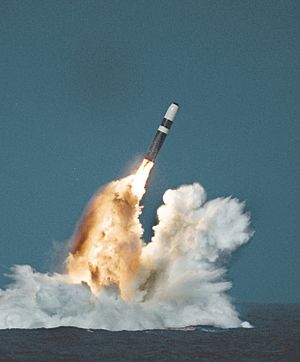Second strike facts for kids
In nuclear strategy, a retaliatory strike is when a country can hit back with powerful nuclear weapons even after being attacked first. This ability is super important for nuclear deterrence. It means convincing an enemy that attacking you first would be a terrible idea, because you could still strike back hard. Without this ability, an enemy might try to win a nuclear war by launching a huge first attack to destroy your nuclear forces.
Contents
Why It Matters: The Theory
Having the ability to strike back (second-strike capability) helps stop a nuclear attack from happening in the first place. It also supports a "no first use" strategy, where a country promises not to use nuclear weapons unless attacked first. When two countries both have this ability, it often leads to a strategy called mutual assured destruction. This means both sides know that if they attack, they will also be destroyed.
Second-strike capability can be made even stronger with "fail-deadly" systems. These systems set a clear line that, if crossed, will definitely lead to consequences. For example, if an allied country is attacked, a pre-planned response, like a nuclear retaliatory strike, might automatically begin.
How It Works: Implementation

The main goal of having second-strike capability is to make sure an enemy's first attack can't wipe out your nuclear weapons. This way, a country can still launch a nuclear response even after being hit. Countries like the United States spread out their nuclear weapons in different ways, often using something called a nuclear triad. This means they have nuclear weapons on land, in the air, and under the sea. This makes it much harder for an enemy to destroy all of them in one go.
Submarines that launch ballistic missiles (SLBMs) are a common way to have second-strike power. They are very hard to find, so they can survive a first attack. However, it's crucial to know exactly who attacked you to avoid hitting the wrong country and making things worse. Countries with nuclear weapons work hard to convince their enemies that a first strike is not worth the risk of a second strike. They do this by having many different ways to launch weapons, plans for various attack situations, launch sites all over the country, and strong underground facilities built to survive a nuclear attack.
Launch on Warning
"Launch on warning" is a strategy where a country launches its nuclear weapons as soon as it detects an incoming enemy attack, before the enemy missiles even hit. This idea became well-known during the Cold War.
Besides the nuclear triad, nations use early warning systems to spot incoming nuclear missiles. This gives them the choice to launch their own retaliatory strike before the first attack lands. This is another way to make second-strike capability stronger and stop an enemy from attacking first.
Older intercontinental ballistic missiles (ICBMs) and submarine-launched missiles weren't very accurate. So, a second strike could only really target large, undefended places like cities. But newer missiles are much more accurate. This means a second strike can now hit an enemy's strong military bases and facilities.
Perimetr-PTS: The Dead Hand
Perimetr-PTS, also known as "мёртвая рука" (the Dead Hand) in Russia, is a special Russian nuclear system. It was designed to automatically launch ballistic missiles as a retaliatory attack if Russia's main command and control system is destroyed in a surprise attack.
The Perimetr-PTS system was developed in 1974 because the Soviet Union worried about surprise nuclear attacks from US submarines. It started working in January 1985. The system was built with many backup layers. This was to make sure it would still work even if many communication systems were destroyed in an attack. Launch orders would be sent by radio from transmitters buried deep underground. The system was updated over the years, adding newer missiles and improvements.
Russian leaders were concerned that the system might accidentally launch missiles. So, they added many safety features:
- First, two important communication systems (Vyuga and Kazbek) had to be cut off at the same time. This would signal that the country's main command center was destroyed and its leaders were gone.
- Second, the military leaders would have had to raise the threat level very high beforehand. If they hadn't, missile operators in the silos could stop the automatic launch.
- Third, information from many sensors was collected by a central computer. These sensors included ground and infrared detectors that could spot explosions near radar stations, command posts, and missile silos. It also used data from radar stations and the Oko early warning satellite system. Perimetr-PTS was specifically designed not to launch if there was a smaller attack from US allies or an Asian nuclear power, because they couldn't fight a "total war." It also ignored earthquakes or natural disasters by checking data from seismograph stations.
Even with its automatic launch abilities, Russian nuclear command could order missiles to self-destruct in mid-flight if there was an accidental launch. Russian ballistic missile submarines were generally not part of the Perimetr-PTS system because of communication problems.
History
As early as 1940, science fiction writer Robert A. Heinlein wrote a science fiction short story called Solution Unsatisfactory. In this story, he described a nuclear arms race between the United States and the Soviet Union. In one part, the US government talks about a scenario where the Soviet Union launches a surprise attack, destroying American cities. But the US military would survive and launch a counter-attack.
See also
- Minimal deterrence
- Doomsday device
- 1983 Soviet nuclear false alarm incident
- Mutual assured destruction

